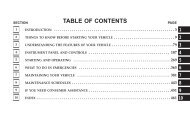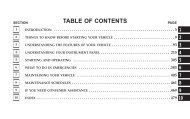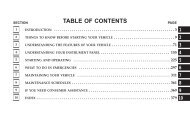8W-01 WIRING DIAGRAM INFORMATION
8W-01 WIRING DIAGRAM INFORMATION
8W-01 WIRING DIAGRAM INFORMATION
Create successful ePaper yourself
Turn your PDF publications into a flip-book with our unique Google optimized e-Paper software.
<strong>8W</strong> - <strong>01</strong> - 10 <strong>8W</strong>-<strong>01</strong> <strong>WIRING</strong> <strong>DIAGRAM</strong> <strong>INFORMATION</strong> HB<br />
TROUBLESHOOTING <strong>WIRING</strong> PROBLEMS<br />
When troubleshooting wiring problems there are six steps which can aid in the procedure. The steps are listed and<br />
explained below. Always check for non-factory items added to the vehicle before doing any diagnosis. If the vehicle<br />
is equipped with these items, disconnect them to verify these add-on items are not the cause of the problem.<br />
1. Verify the problem.<br />
2. Verify any related symptoms. Do this by performing operational checks on components that are in the same<br />
circuit. Refer to the wiring diagrams.<br />
3. Analyze the symptoms. Use the wiring diagrams to determine what the circuit is doing, where the problem most<br />
likely is occurring and where the diagnosis will continue.<br />
4. Isolate the problem area.<br />
5. Repair the problem area.<br />
6. Verify the proper operation. For this step, check for proper operation of all items on the repaired circuit. Refer to<br />
the wiring diagrams.<br />
STANDARD PROCEDURE<br />
STANDARD PROCEDURE - ELECTROSTATIC DISCHARGE (ESD) SENSITIVE<br />
DEVICES<br />
All ESD sensitive components are solid state and a<br />
symbol is used to indicate this. When handling any<br />
component with this symbol, comply with the following<br />
procedures to reduce the possibility of electrostatic<br />
charge build up on the body and inadvertent discharge<br />
into the component. If it is not known whether the part<br />
is ESD sensitive, assume that it is.<br />
1. Always touch a known good ground before handling<br />
the part. This should be repeated while handling<br />
the part and more frequently after sliding<br />
across a seat, sitting down from a standing position,<br />
or walking a distance.<br />
2. Avoid touching electrical terminals of the part, unless instructed to do so by a written procedure.<br />
3. When using a voltmeter, be sure to connect the ground lead first.<br />
4. Do not remove the part from it’s protective packing until it is time to install the part.<br />
5. Before removing the part from it’s package, ground the package to a known good ground on the vehicle.

















